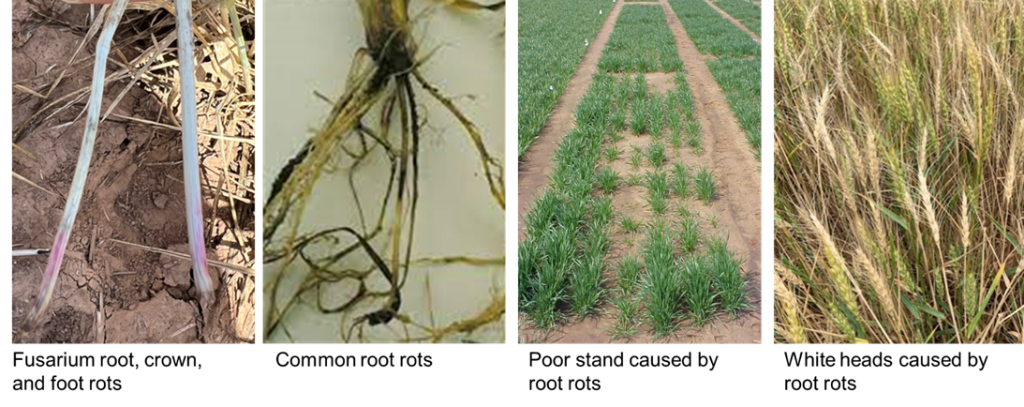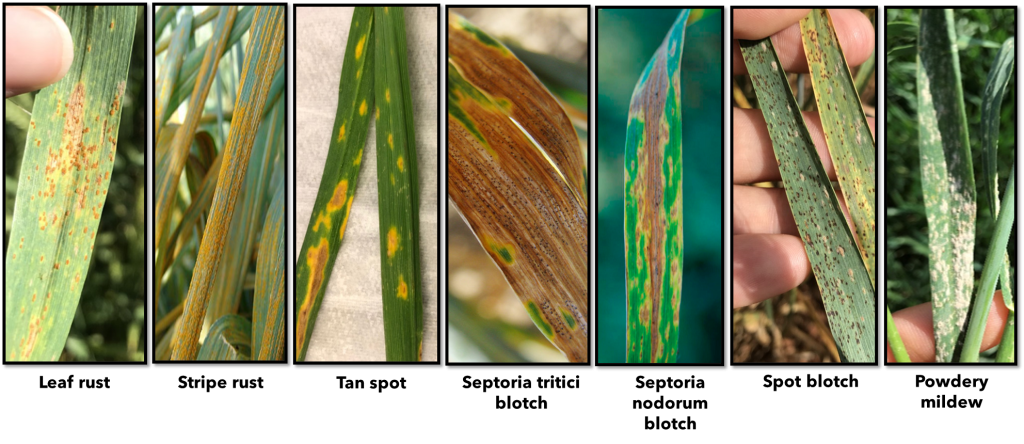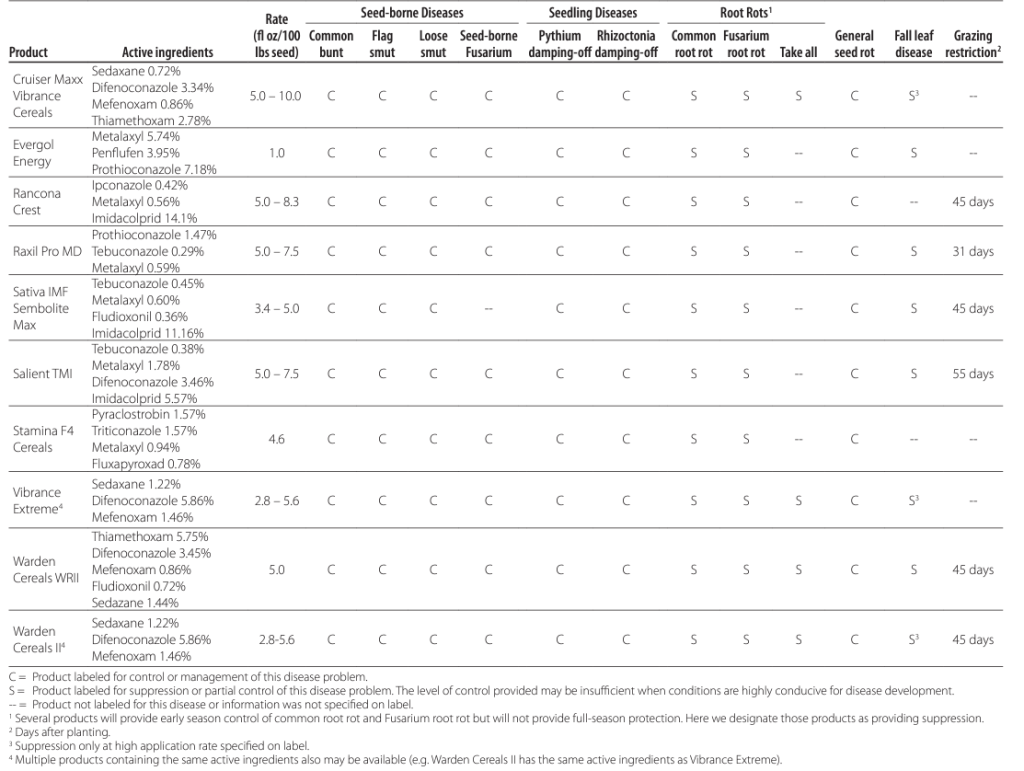Disease management considerations to make before planting wheat this fall
Categories: Disease management
Meriem Aoun, Small Grains Pathologist
Department of Entomology & Plant Pathology, Oklahoma State University
As we start the new wheat season in Oklahoma, diverse disease management strategies can be made this fall to reduce damages later in the season. These strategies include cultural practices, variety selection, and chemical control.
Planting date: Much of the winter wheat sown in Oklahoma is used as a dual-purpose crop. In such a system, wheat is grazed by cattle from late fall through late winter/early spring and then harvested for grain in early summer. In a grain-only system, wheat is generally planted in October, but in a dual-purpose system wheat is planted in early to mid-September to maximize forage production. Early planted wheat is prone to infection by aphid-transmitted virus (i.e., barley yellow dwarf virus; Figure 1), and mite-transmitted viruses including wheat streak mosaic virus (WSMV; Figure 2), high plains wheat mosaic virus (HPMV), and Triticum mosaic virus. Therefore, delayed planting can reduce virus fall infection.
 Figure 1. Symptoms of barley yellow dwarf (BYD) in a farmer field in Cleveland County, OK (photo taken on April 26, 2022). Aphids that transmit BYDV are shown in the picture on the right.
Figure 1. Symptoms of barley yellow dwarf (BYD) in a farmer field in Cleveland County, OK (photo taken on April 26, 2022). Aphids that transmit BYDV are shown in the picture on the right.
 Figure 2. Symptoms of wheat streak mosaic (WSM) in a farmer field in Grady County, OK (photo taken on April 13, 2022). Wheat curl mites that transmit WSMV are shown in the picture on the right (photo credit: University of Kentucky).
Figure 2. Symptoms of wheat streak mosaic (WSM) in a farmer field in Grady County, OK (photo taken on April 13, 2022). Wheat curl mites that transmit WSMV are shown in the picture on the right (photo credit: University of Kentucky).
Destroy volunteer wheat and grassy weeds: This is critical to reduce the populations of mites and aphids that transmit viruses to seedling wheat. Wheat infected in the fall will be severely damaged next spring. Although virus infection can also occur in the spring, fall infection is usually more damaging because virus has a longer time to damage plants as compared to infections that occur in the spring. Hence, it is imperative to control volunteer wheat and grassy weeds in commercial wheat fields and adjacent fields. For example, wheat curl mite life span is 7-10 days, thus destroying volunteer wheat for a period of at least two weeks prior to planting will greatly reduce mite population in the fall.
Over the last eight years, high incidence and severity were reported in Oklahoma in years 2017 and 2022. In 2022, 57 wheat samples were tested by the Plant Disease and Insect Diagnostic Lab at OSU for the presence of mite-transmitted viruses. Of these 57 samples, 17 (30%) tested positive for WSMV and 8 (14%) tested positive for HPMV. In 2017, of the 103 tested samples, 69 (67%) tested positive for WSMV and 22 (21%) tested positive for HPMV. Later planting date in conjunction with limiting the green bridge can help reduce damages by mite-transmitted viruses in Oklahoma.
Seed treatments: The use of systemic insecticides that contain imidacloprid or thiamethoxam can be used to control aphids that transmit barley yellow dwarf virus. Seed treatment using insecticides is not effective in controlling curl mites or the mite-transmitted viruses. Seed treatments using fungicides and later planting can reduce dry land root rots such as common root rots and Fusarium root/crown rots that were prevalent and severe during the last three seasons (2022-2024) in Oklahoma (Figure 3). Fungicide seed treatments may not necessarily affect root rots in spring, but generally facilitates stand establishment and improves yield. With the lack of varieties with acceptable levels of resistance to root rots, managing root rots is difficult.
 Figure 3. Symptoms of Fusarium root/crown/foot rots and common root rots. Root rots result in poor stand and white heads.
Figure 3. Symptoms of Fusarium root/crown/foot rots and common root rots. Root rots result in poor stand and white heads.
Seed treatments using fungicides are also effective to control common bunt (also called stinking smut because of its ‘fishy’ odor) and loose smut (Figure 4). If either common bunt or loose smut was observed in a field last season, It is not recommended to use grain harvested from such field as seed this year. However, if grain harvested from such contaminated fields must be used as seed, seed treatment at a high rate should be applied. Fungicide seed treatments can also help control fall foliar diseases such as leaf rust, stripe rust, tan spot, spot blotch, Septoria nodorum/tritici blotch, and powdery mildew (Figure 5).
 Figure 4. Common bunt/stinking smut (photo on the left) and loose smut (photo on the right).
Figure 4. Common bunt/stinking smut (photo on the left) and loose smut (photo on the right).
 Figure 5. Wheat foliar fungal diseases.
Figure 5. Wheat foliar fungal diseases.
For more information on seed treatment options consult the “2023 OSU Extension Agents’ Handbook of Insect, Plant Disease, and Weed Control” that should be available with County Extension Educators. Wheat seed treatments that are frequently used in Kansas to manage wheat diseases are listed in Table 1.
Table 1. Wheat seed treatments commonly used in Kansas (Source: Dr. Kelsey and Dr. Erick De Wolf, 2023; MF2955).

Select disease resistant varieties: One of the most effective and sustainable ways to manage diseases is to grow resistant varieties. Information about OSU wheat variety characteristics, including disease resistance levels can be found at https://extension.okstate.edu/programs/wheat-research-and-extension/varieties-characteristics/.